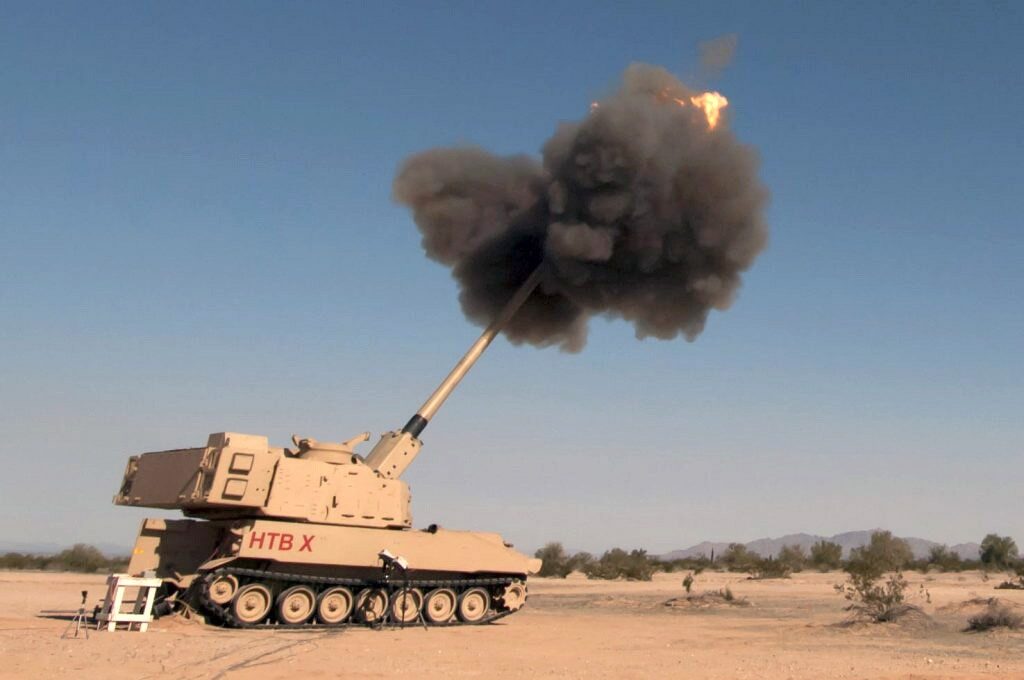By SYDNEY J. FREEDBERG JR.
WASHINGTON: The latest version of the 57-year-old M109 armored howitzer just threw two different types of shell 65 kilometers downrange, just over 40 miles, in a test today at Yuma Proving Ground. That’s more than twice the range of the current model, even using rocket-boosted ammunition.
And the Army’s Extended Range Cannon Artillery (ERCA) program is already working on further upgrades, including shells with built-in ramjets for yet greater range.
Then-Col. John Rafferty teaches field artillery operations in Tajikistan.
“The platform that was showcased today, we’re already on contract with BAE for that,” with 18 howitzers – a full battalion – entering service in 2023, Brig. Gen. John Rafferty, modernization director for Long-Range Precision Fires, told reporters this afternoon. “The Increment 2 version will be separate contract.”
The Army will hold an industry day for companies interested in Increment 2 “probably in the next three to four months, once we get the acquisition strategy approved,” Rafferty continued.
But companies aren’t waiting for that day of briefings to work on new technology.
“One of our industry partners will demonstrate ramjet capability later this year,” he said. “The ramjet is something that we’re looking at for a longer-range 155 [millimeter] projectile. There’s ramjets, there’s hypervelocity projectiles [originally developed for Navy railguns], there’s competitors for that [longer-ranged round]. We’re looking at what’s next.”
A first-generation M109 howitzer on the Cambodia-Vietnam border
What was test-fired today was a prototype of the tank-like mobile howitzer the Army’s calling the M1299. It’s actually a direct descendant of the M109 howitzer that first entered service in 1963, but at this point, every component of the original design has been replaced with something new at least once, much like the parable of Lincoln’s axe. BAE already rebuilt the chassis and automotive components completely in M109A7 PIM version currently in production, but the gun in the turret remains the same as on the A6 Paladin model; the M1299 takes the PIM chassis and puts a new weapon on top.
The most obvious feature of that weapon is a 49 percent longer barrel (58 calibers instead of 39), which contains the rapidly expanding propellant gasses longer so they can accelerate the projectile to greater speeds before they exit the muzzle and dissipate. But the propellant itself – in layman’s terms, the gunpowder – is also different, what one officer called “super-charged,” which required redesigning the howitzer to handle the higher pressure.
In today’s test, the new ERCA weapon fired two different projectiles: the latest version of the battle-tested Raytheon Excalibur, a precision-guided shell used in Afghanistan and Iraq; and the all-new General Dynamics XM1113 Rocket Assisted Projectile, replacing the Cold War-era M549. Both used the super-charged propellant, and both successfully flew 65 km, but the Excalibur also hit a precision target, Rafferty said, without adding further details.

The XM1299 Extended Range Cannon Artillery (ERCA) howitzer in an earlier test shot last year.
One big piece missing from today’s demonstration: the auto-loader mechanism meant to replace human loaders, who swiftly grow fatigued and injury-prone after manhandling multiple 95-lb shells. It will grab the desired type of shell from the ready rack, add the appropriate amount of propellant (in pre-measured bags) for the desired range, and even set the fuse, a task which currently requires two soldiers working together under the supervision of a sergeant. The autoloader will increase the howitzer’s rate of fire as high as 10 rounds a minute, the Army says – that’s one shell every six seconds.
The Army’s eager to use NRO, NGA, and other agencies’ satellites to spot far targets for its new thousand-mile missiles, not to build its own, the deputy chief of staff for intelligence said.
Maj. Gen. John George, head of Army Combat Capabilities Development Command, checks out the XM1299.
The autoloader is currently under development at Picatinny Arsenal, New Jersey, where the Army says it’s making rapid progress. By the end of the year, it will undergo a test – in the lab, not in the field – to qualify for what’s called Technological Readiness Level 6, demonstrated to work in a “relevant environment.” A field test (TRL 7) will follow in 2021, getting the autoloader ready to be fielded with the ERCA cannon and the M1113 shell in 2023.
A separate program is developing a robotic vehicle to carry spare ammunition.
This rapid schedule is the result of the Army’s new urgent, streamlined approach to modernizing against Russian and Chinese threats, said the service’s Vice-Chief of Staff. In contrast to decades-long development timelines in the past, Gen. Joseph Martin told reporters on the call, “this was hatched in 2018; by 2023 we’ll have a battalion.”

Then-Maj. Gen. Joseph Martin in Afghanistan
And that’s not just 18 howitzers sitting in a motor pool somewhere, Martin emphasized, but a functioning artillery unit manned by soldiers trained and organized to use the new weapon to the fullest. That will give division commanders a new option for long-range attack alongside their existing drones and helicopters, which are vulnerable to enemy anti-aircraft systems in a way that artillery shells are not.
The howitzer and other new Long-Range Precision Fires weapons, like the Precision Strike Missile and hypersonics, will in turn be part of a much larger ecosystem of complementary technologies. The Army’s working on artificial intelligence and wireless networks so its weapons can receive targeting data, not only from the service’s own next-generation drones, but from Air Force, Navy, Marine, and Space Force reconnaissance assets as well.
“We’re going to continue to innovate – crawl, walk, run over the next three years – integrating more and more Army developed capabilities that mature and joint capabilities,” Gen. Martin said. “[It’s] our contribution to JADC2 [Joint All-Domain Command and Control]. We’re building ours from the ground up.”
No comments:
Post a Comment